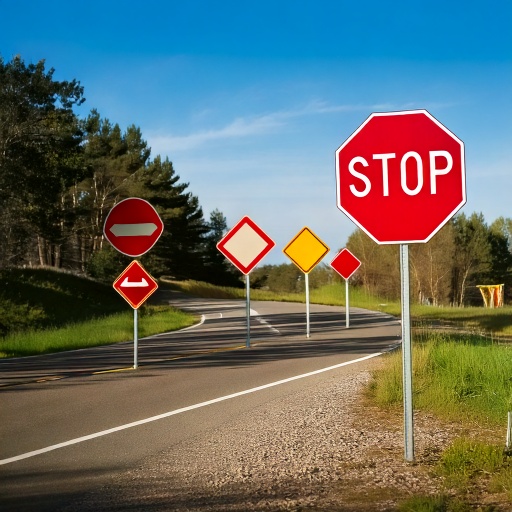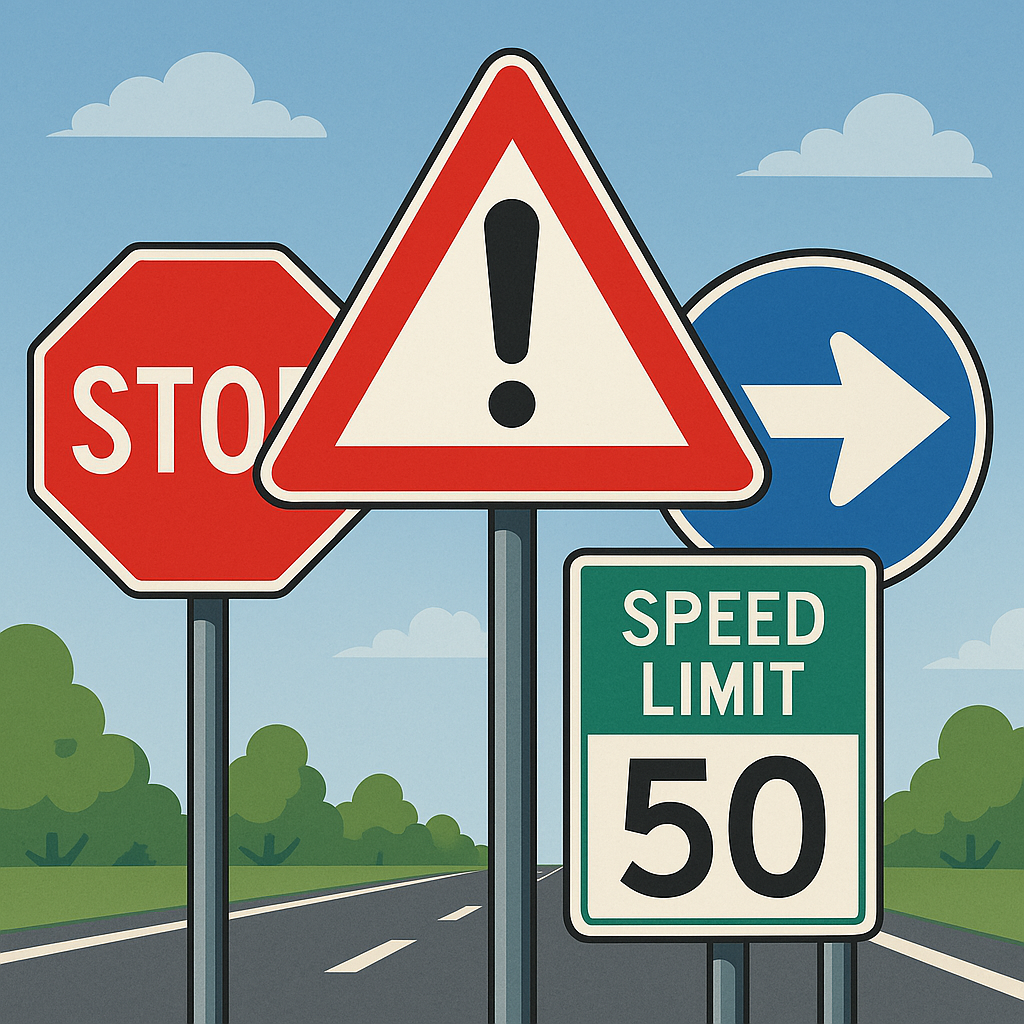🧭 1. Introduction
Every time you drive, you rely on a system of communication that doesn’t use words it uses shapes, colors, and symbols, These are road signs, and understanding them is one of the most fundamental skills every driver must have, From ensuring safety to helping you reach your destination, road signs play a silent but powerful role in every journey.
Whether you’re a learner or have decades behind the wheel, this guide will help refresh your knowledge of road signs and explain why they matter now more than ever.
🗂️ Table of Contents
⚠️ 2. Why Road Signs Matter
Road signs are not random metal boards they are carefully designed tools that serve several purposes :
• Safety : They warn you about upcoming hazards such as sharp turns, pedestrian crossings, or merging traffic.
• Order : Road signs create structure in traffic, helping prevent confusion and road rage.
• Legal Compliance : Many signs indicate legal obligations, such as speed limits or no-parking zones. Failing to obey these signs can result in costly penalties or dangerous situations on the road.
• Guidance : Road signs help you find your way and make driving more predictable and comfortable.
Failing to understand or obey road signs is one of the leading causes of traffic violations and accidents worldwide, That’s why road signs are essential to any safe driving strategy.
🛑 3. Categories of Road Signs
Road signs are grouped into different categories based on their purpose, Let’s take a closer look at the key categories every driver should recognize :
🧱 Regulatory Signs
These signs communicate mandatory rules that drivers are legally required to follow.. They include stop signs, yield signs, no entry signs, and speed limits, Disregarding these signs can lead to legal trouble or put lives at risk.
⚠️ Warning Signs
These alert you to potential dangers ahead curves, intersections, slippery roads, or animal crossings typically, they are yellow and shaped like diamonds.
🧭 Guide Signs
These provide helpful directions and information, such as route markers, destination distances, or highway exits.
🚧 Temporary Signs
Often orange, these signs appear in construction or maintenance zones and temporarily override other signage for safety.
🅿️ Service Signs
Usually blue, these direct drivers to essential services such as hospitals, gas stations, or rest areas.
Knowing the category of a road sign helps drivers immediately understand its importance and urgency.
🤯 4. Commonly Misunderstood Signs
Even experienced drivers sometimes misinterpret these signs :
• Yield vs. Stop : A yield sign doesn’t mean stop, It means slow down and give right of way.
• Roundabout Sign : Some drivers confuse this with a “go in circles” message, It actually means there is a roundabout ahead.
• Speed Limit Ends Sign : This doesn’t mean you can go as fast as you like, but rather return to the general speed limit for that road type.
• No U-Turn vs. No Left Turn : A quick glance may not reveal the difference unless you’re paying close attention.
Avoiding these mistakes can significantly reduce the risk of collisions.

📘 5. How to Learn Road Signs Effectively
Don’t wait until your license exam or a near-miss to brush up on road signs, Here’s how to make learning easier :
• 📱 Use Mobile Apps : Try apps like “DMV Genie” or “Driving Theory Test” to practice on the go.
• 📖 Read the Driver’s Manual : Most countries provide an official guide that’s rich with sign explanations.
• 🛣️ Practice Observation : Next time you’re in a car (as driver or passenger), challenge yourself to name every sign you see.
• 🧠 Flashcards Work! : Make or download road sign flashcards to drill your knowledge consistently.
🧠 6. Road Signs and Human Behavior
Road signs are designed with human psychology in mind :
• Color Associations : Red signals danger or prohibition, yellow means caution, green gives permission or guidance.
• Shape Logic : Octagons mean stop, triangles mean yield, circles indicate regulatory instructions.
• Reaction Time : A sign placed at the right distance gives drivers time to react safely, Poor visibility or unfamiliar signs slow that reaction time.
This is why sign placement and design follow strict standards worldwide to minimize guesswork and keep drivers alert.
🔄 7. Adapting to Regional Differences
If you drive in a new country or region, you may encounter unfamiliar road signs, While many international signs are based on global conventions, there can still be differences:
• Language Barriers : Some signs use words rather than symbols.
• Different Colors or Shapes : For example, European stop signs are octagonal like in the U.S., but some warning signs may be triangular instead of diamond-shaped.
• Driving Side : In left-driving countries, directional signage may be flipped.
It’s wise to study local road sign guides before driving abroad.
✅ 8. Conclusion
Understanding road signs is a foundational part of driving safely, It’s not just about passing a driving test it’s about making daily choices that protect your life and the lives of others, Knowing the difference between a guide sign and a warning sign, or between a yield and a stop sign, empowers you to drive confidently and responsibly.
So next time you’re on the road, pay attention to every sign, Each one carries a message meant just for you to inform, to guide, and most importantly, to protect.
📌 Internal Link :
10 Dangerous Driving Behaviors You Should Stop Immediately
🌐 External Source :

